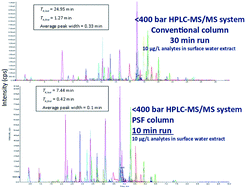当前位置:
X-MOL 学术
›
Anal. Methods
›
论文详情
Our official English website, www.x-mol.net, welcomes your feedback! (Note: you will need to create a separate account there.)
A high-throughput and high peak capacity narrow-bore parallel segmented flow column strategy for the liquid chromatography-tandem mass spectrometry analysis of organic contaminants in water
Analytical Methods ( IF 3.1 ) Pub Date : 2019/12/23 , DOI: 10.1039/c9ay02370d Arianne Soliven 1, 2, 3, 4, 5 , Lucia Pareja 4, 6, 7, 8, 9 , R. Andrew Shalliker 10, 11, 12, 13, 14 , Horacio Heinzen 1, 2, 3, 4, 5 , Andrés Pérez-Parada 4, 9, 15, 16, 17
Analytical Methods ( IF 3.1 ) Pub Date : 2019/12/23 , DOI: 10.1039/c9ay02370d Arianne Soliven 1, 2, 3, 4, 5 , Lucia Pareja 4, 6, 7, 8, 9 , R. Andrew Shalliker 10, 11, 12, 13, 14 , Horacio Heinzen 1, 2, 3, 4, 5 , Andrés Pérez-Parada 4, 9, 15, 16, 17
Affiliation

|
This study highlights the development of a high peak capacity, high-throughput (HTP) approach for a target list of 62 organic contaminants in an environmental river water matrix on a HPLC conventional 400 bar system. Key separation metrics were evaluated: (a) peak capacity, (b) total analysis time and (c) mobile phase consumption. An average peak width of 0.10 min with a total analysis time (inclusive of the column wash and re-equilibration) of 10 minutes revealed the increased productivity and performance of the parallel segmented flow (PSF) column technology HPLC-MS strategy, comparable to UHPLC peak widths and analysis times, achieved at a significantly lower backpressure (<400 bar). The operation of the PSF in a narrow-bore scale format (internal diameter of 2.1 mm) resulted in a conservative HPLC scale total mobile phase consumption of 15 mL for the column separation; only 5.5 mL of this volume was exposed to the ion source per injection. Mobile phase consumption was higher compared to that of UHPLC, but on the other hand it achieved higher peak capacity. Three representative compounds (atrazine, diclofenac and fluazuron) with differing retention and ionisation properties were studied in detail in terms of detection sensitivity. The majority of the ion ratios for the standards in the river water matrix were within ±30% of the average ion ratios. The largest ion suppression occurred for atrazine (−25% matrix effect), a pesticide notorious for poor ionization and poor peak shape issues. The lowest response transitions at 1 μg L−1 for the extracted ions in the river water matrix of atrazine, diclofenac and fluazuron had signal to noise ratios ≥3, with the exception of diclofenac where 5 μg L−1 was the lowest calibration level. The peak area's calibration curve slope and standard deviation in the detector's response determination of limit of quantification (LOQ) were between 5.2 and 30.4 μg L−1.
中文翻译:

高效液相色谱-串联质谱分析水中有机污染物的高通量和高峰容量窄口平行分段流柱策略
这项研究着重介绍了一种高峰容量,高通量(HTP)方法的开发,该方法可在HPLC传统的400 bar系统上将环境河流水基体中的62种有机污染物目标清单作为目标。评估了关键的分离指标:(a)峰容量,(b)总分析时间和(c)流动相消耗量。平均峰宽为0.10分钟,总分析时间为10分钟(包括柱洗和重新平衡),揭示了平行分段流(PSF)柱技术HPLC-MS策略与UHPLC相比具有更高的生产率和性能峰宽和分析时间,在明显较低的背压(<400 bar)下实现。PSF以窄口径格式(内径2)操作。1 mm)色谱柱分离导致保守的HPLC规模的总流动相消耗为15 mL; 每次进样仅将5.5mL的体积暴露于离子源。与UHPLC相比,流动相消耗量更高,但另一方面,它实现了更高的峰容量。在检测灵敏度方面详细研究了三种具有不同保留和电离特性的代表性化合物((去津,双氯芬酸和氟嘧隆)。河流水基质中标准品的大多数离子比在平均离子比的±30%之内。最大的离子抑制作用发生于阿特拉津(−25%的基质效应),该农药因电离差和峰形问题不佳而臭名昭著。最低的响应跃迁为1μgL 每次进样将5 mL的该体积暴露于离子源。与UHPLC相比,流动相消耗量更高,但另一方面,它实现了更高的峰容量。在检测灵敏度方面详细研究了三种具有不同保留和电离特性的代表性化合物((去津,双氯芬酸和氟嘧隆)。河流水基质中标准品的大多数离子比在平均离子比的±30%之内。最大的离子抑制作用发生于阿特拉津(−25%的基质效应),该农药因电离差和峰形问题不佳而臭名昭著。最低的响应跃迁为1μgL 每次进样将5 mL的该体积暴露于离子源。与UHPLC相比,流动相消耗量更高,但另一方面,它实现了更高的峰容量。在检测灵敏度方面详细研究了三种具有不同保留和电离特性的代表性化合物((去津,双氯芬酸和氟嘧隆)。河流水基质中标准品的大多数离子比在平均离子比的±30%之内。最大的离子抑制作用发生于阿特拉津(−25%的基质效应),该农药因电离差和峰形问题不佳而臭名昭著。最低的响应跃迁为1μgL 根据检测灵敏度,对具有不同保留和电离特性的双氯芬酸和氟尿嘧啶进行了详细研究。河流水基质中标准品的大多数离子比在平均离子比的±30%之内。最大的离子抑制作用发生于阿特拉津(−25%的基质效应),该农药因电离差和峰形问题不佳而臭名昭著。最低的响应跃迁为1μgL 根据检测灵敏度,对具有不同保留和电离特性的双氯芬酸和氟尿嘧啶进行了详细研究。河流水基质中标准品的大多数离子比在平均离子比的±30%之内。最大的离子抑制作用发生于阿特拉津(−25%的基质效应),该农药因电离差和峰形问题不佳而臭名昭著。最低的响应跃迁为1μgL对于at去津,双氯芬酸和氟嘧隆的河水基质中提取离子的-1的信噪比≥3,双氯芬酸除外,其中5μgL -1是最低校准水平。检测器对定量限(LOQ)的响应测定中的峰面积校准曲线斜率和标准偏差在5.2和30.4μgL -1之间。
更新日期:2020-02-13
中文翻译:

高效液相色谱-串联质谱分析水中有机污染物的高通量和高峰容量窄口平行分段流柱策略
这项研究着重介绍了一种高峰容量,高通量(HTP)方法的开发,该方法可在HPLC传统的400 bar系统上将环境河流水基体中的62种有机污染物目标清单作为目标。评估了关键的分离指标:(a)峰容量,(b)总分析时间和(c)流动相消耗量。平均峰宽为0.10分钟,总分析时间为10分钟(包括柱洗和重新平衡),揭示了平行分段流(PSF)柱技术HPLC-MS策略与UHPLC相比具有更高的生产率和性能峰宽和分析时间,在明显较低的背压(<400 bar)下实现。PSF以窄口径格式(内径2)操作。1 mm)色谱柱分离导致保守的HPLC规模的总流动相消耗为15 mL; 每次进样仅将5.5mL的体积暴露于离子源。与UHPLC相比,流动相消耗量更高,但另一方面,它实现了更高的峰容量。在检测灵敏度方面详细研究了三种具有不同保留和电离特性的代表性化合物((去津,双氯芬酸和氟嘧隆)。河流水基质中标准品的大多数离子比在平均离子比的±30%之内。最大的离子抑制作用发生于阿特拉津(−25%的基质效应),该农药因电离差和峰形问题不佳而臭名昭著。最低的响应跃迁为1μgL 每次进样将5 mL的该体积暴露于离子源。与UHPLC相比,流动相消耗量更高,但另一方面,它实现了更高的峰容量。在检测灵敏度方面详细研究了三种具有不同保留和电离特性的代表性化合物((去津,双氯芬酸和氟嘧隆)。河流水基质中标准品的大多数离子比在平均离子比的±30%之内。最大的离子抑制作用发生于阿特拉津(−25%的基质效应),该农药因电离差和峰形问题不佳而臭名昭著。最低的响应跃迁为1μgL 每次进样将5 mL的该体积暴露于离子源。与UHPLC相比,流动相消耗量更高,但另一方面,它实现了更高的峰容量。在检测灵敏度方面详细研究了三种具有不同保留和电离特性的代表性化合物((去津,双氯芬酸和氟嘧隆)。河流水基质中标准品的大多数离子比在平均离子比的±30%之内。最大的离子抑制作用发生于阿特拉津(−25%的基质效应),该农药因电离差和峰形问题不佳而臭名昭著。最低的响应跃迁为1μgL 根据检测灵敏度,对具有不同保留和电离特性的双氯芬酸和氟尿嘧啶进行了详细研究。河流水基质中标准品的大多数离子比在平均离子比的±30%之内。最大的离子抑制作用发生于阿特拉津(−25%的基质效应),该农药因电离差和峰形问题不佳而臭名昭著。最低的响应跃迁为1μgL 根据检测灵敏度,对具有不同保留和电离特性的双氯芬酸和氟尿嘧啶进行了详细研究。河流水基质中标准品的大多数离子比在平均离子比的±30%之内。最大的离子抑制作用发生于阿特拉津(−25%的基质效应),该农药因电离差和峰形问题不佳而臭名昭著。最低的响应跃迁为1μgL对于at去津,双氯芬酸和氟嘧隆的河水基质中提取离子的-1的信噪比≥3,双氯芬酸除外,其中5μgL -1是最低校准水平。检测器对定量限(LOQ)的响应测定中的峰面积校准曲线斜率和标准偏差在5.2和30.4μgL -1之间。



























 京公网安备 11010802027423号
京公网安备 11010802027423号